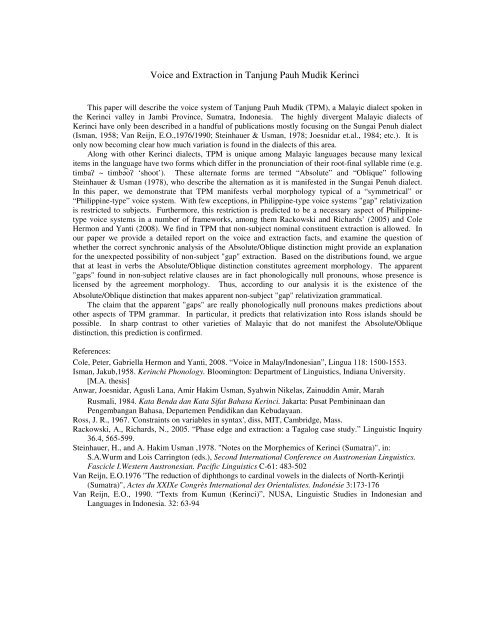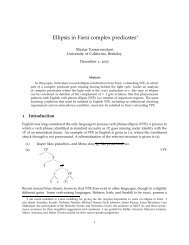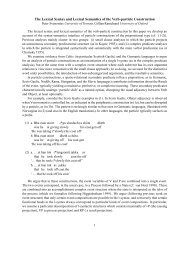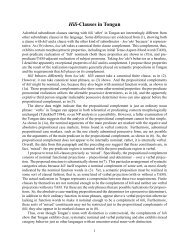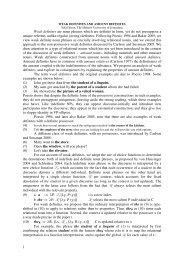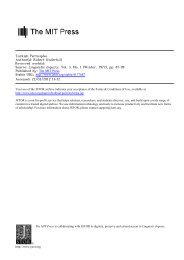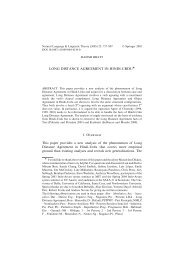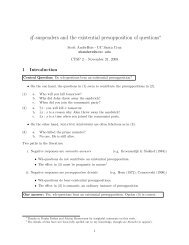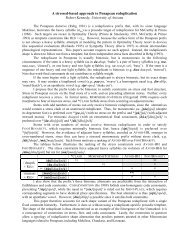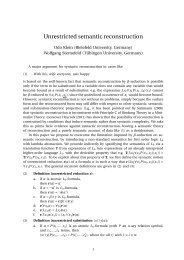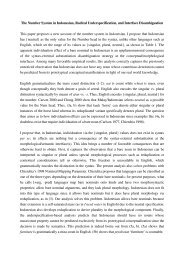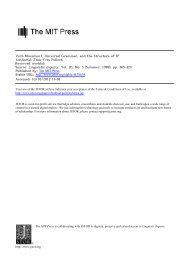Voice and Extraction in Tanjung Pauh Mudik Kerinci
Voice and Extraction in Tanjung Pauh Mudik Kerinci
Voice and Extraction in Tanjung Pauh Mudik Kerinci
Create successful ePaper yourself
Turn your PDF publications into a flip-book with our unique Google optimized e-Paper software.
<strong>Voice</strong> <strong>and</strong> <strong>Extraction</strong> <strong>in</strong> <strong>Tanjung</strong> <strong>Pauh</strong> <strong>Mudik</strong> Ker<strong>in</strong>ci<br />
This paper will describe the voice system of <strong>Tanjung</strong> <strong>Pauh</strong> <strong>Mudik</strong> (TPM), a Malayic dialect spoken <strong>in</strong><br />
the Ker<strong>in</strong>ci valley <strong>in</strong> Jambi Prov<strong>in</strong>ce, Sumatra, Indonesia. The highly divergent Malayic dialects of<br />
Ker<strong>in</strong>ci have only been described <strong>in</strong> a h<strong>and</strong>ful of publications mostly focus<strong>in</strong>g on the Sungai Penuh dialect<br />
(Isman, 1958; Van Reijn, E.O.,1976/1990; Ste<strong>in</strong>hauer & Usman, 1978; Joesnidar et.al., 1984; etc.). It is<br />
only now becom<strong>in</strong>g clear how much variation is found <strong>in</strong> the dialects of this area.<br />
Along with other Ker<strong>in</strong>ci dialects, TPM is unique among Malayic languages because many lexical<br />
items <strong>in</strong> the language have two forms which differ <strong>in</strong> the pronunciation of their root-f<strong>in</strong>al syllable rime (e.g.<br />
timba/ ~ timbə°o/ ‘shoot’). These alternate forms are termed “Absolute” <strong>and</strong> “Oblique” follow<strong>in</strong>g<br />
Ste<strong>in</strong>hauer & Usman (1978), who describe the alternation as it is manifested <strong>in</strong> the Sungai Penuh dialect.<br />
In this paper, we demonstrate that TPM manifests verbal morphology typical of a “symmetrical” or<br />
“Philipp<strong>in</strong>e-type” voice system. With few exceptions, <strong>in</strong> Philipp<strong>in</strong>e-type voice systems "gap" relativization<br />
is restricted to subjects. Furthermore, this restriction is predicted to be a necessary aspect of Philipp<strong>in</strong>etype<br />
voice systems <strong>in</strong> a number of frameworks, among them Rackowski <strong>and</strong> Richards’ (2005) <strong>and</strong> Cole<br />
Hermon <strong>and</strong> Yanti (2008). We f<strong>in</strong>d <strong>in</strong> TPM that non-subject nom<strong>in</strong>al constituent extraction is allowed. In<br />
our paper we provide a detailed report on the voice <strong>and</strong> extraction facts, <strong>and</strong> exam<strong>in</strong>e the question of<br />
whether the correct synchronic analysis of the Absolute/Oblique dist<strong>in</strong>ction might provide an explanation<br />
for the unexpected possibility of non-subject "gap" extraction. Based on the distributions found, we argue<br />
that at least <strong>in</strong> verbs the Absolute/Oblique dist<strong>in</strong>ction constitutes agreement morphology. The apparent<br />
"gaps" found <strong>in</strong> non-subject relative clauses are <strong>in</strong> fact phonologically null pronouns, whose presence is<br />
licensed by the agreement morphology. Thus, accord<strong>in</strong>g to our analysis it is the existence of the<br />
Absolute/Oblique dist<strong>in</strong>ction that makes apparent non-subject "gap" relativization grammatical.<br />
The claim that the apparent "gaps" are really phonologically null pronouns makes predictions about<br />
other aspects of TPM grammar. In particular, it predicts that relativization <strong>in</strong>to Ross isl<strong>and</strong>s should be<br />
possible. In sharp contrast to other varieties of Malayic that do not manifest the Absolute/Oblique<br />
dist<strong>in</strong>ction, this prediction is confirmed.<br />
References:<br />
Cole, Peter, Gabriella Hermon <strong>and</strong> Yanti, 2008. “<strong>Voice</strong> <strong>in</strong> Malay/Indonesian”, L<strong>in</strong>gua 118: 1500-1553.<br />
Isman, Jakub,1958. Ker<strong>in</strong>chi Phonology. Bloom<strong>in</strong>gton: Department of L<strong>in</strong>guistics, Indiana University.<br />
[M.A. thesis]<br />
Anwar, Joesnidar, Agusli Lana, Amir Hakim Usman, Syahw<strong>in</strong> Nikelas, Za<strong>in</strong>udd<strong>in</strong> Amir, Marah<br />
Rusmali, 1984. Kata Benda dan Kata Sifat Bahasa Ker<strong>in</strong>ci. Jakarta: Pusat Pemb<strong>in</strong><strong>in</strong>aan dan<br />
Pengembangan Bahasa, Departemen Pendidikan dan Kebudayaan.<br />
Ross, J. R., 1967. 'Constra<strong>in</strong>ts on variables <strong>in</strong> syntax', diss, MIT, Cambridge, Mass.<br />
Rackowski, A., Richards, N., 2005. “Phase edge <strong>and</strong> extraction: a Tagalog case study.” L<strong>in</strong>guistic Inquiry<br />
36.4, 565-599.<br />
Ste<strong>in</strong>hauer, H., <strong>and</strong> A. Hakim Usman ,1978. "Notes on the Morphemics of Ker<strong>in</strong>ci (Sumatra)", <strong>in</strong>:<br />
S.A.Wurm <strong>and</strong> Lois Carr<strong>in</strong>gton (eds.), Second International Conference on Austronesian L<strong>in</strong>guistics.<br />
Fascicle I.Western Austronesian. Pacific L<strong>in</strong>guistics C-61: 483-502<br />
Van Reijn, E.O.1976 "The reduction of diphthongs to card<strong>in</strong>al vowels <strong>in</strong> the dialects of North-Ker<strong>in</strong>tji<br />
(Sumatra)", Actes du XXIXe Congrès International des Orientalistes. Indonésie 3:173-176<br />
Van Reijn, E.O., 1990. “Texts from Kumun (Ker<strong>in</strong>ci)”, NUSA, L<strong>in</strong>guistic Studies <strong>in</strong> Indonesian <strong>and</strong><br />
Languages <strong>in</strong> Indonesia. 32: 63-94
Appendix: Support<strong>in</strong>g Data<br />
(1) Examples Illustrat<strong>in</strong>g the Absolute/Oblique Dist<strong>in</strong>ction <strong>in</strong> Verbs<br />
Sample TMP Ker<strong>in</strong>ci verbs <strong>and</strong> their alternat<strong>in</strong>g forms:<br />
TPM<br />
English St<strong>and</strong>ard Indonesian Absolute Form Oblique form<br />
‘to eat’ makan maka mak´n<br />
‘to p<strong>in</strong>ch’ cubit sibɔt sibit<br />
‘to help’ tolong tulɔ tulɔN<br />
Sample sentences with the Absolute/Oblique verb forms:<br />
Absolute Form: (without direct object)<br />
ka ndə°o/ maka m<strong>in</strong>ən lah.<br />
1sg.N FUT eat.A now.N just.N<br />
‘I am go<strong>in</strong>g to eat right now.”<br />
Oblique form: (with/without direct object)<br />
ka ndə°o/ mak makən mak<br />
nasa͡ε m<strong>in</strong>ən lah<br />
1sg.N FUT.N eat.O rice.A now.N just.N<br />
“I am go<strong>in</strong>g to eat rice right now.”<br />
*ka ndə°o/ mak maka mak<br />
nasa͡ε m<strong>in</strong>ən lah<br />
1sg.N FUT.N eat.O rice.A now.N just.N<br />
(2) Non-subject "gap" extraction <strong>in</strong> TPM<br />
sapo (Nən) Heri nimbə°o/.<br />
who.N (REL.N) Heri N-shoot.O<br />
‘Who did Heri shoot?’<br />
badut Nən Heri nimbə°o/ tah tiNga͡ε.<br />
clown.N REL.N Heri N-shoot.O DEM.N tall.A.<br />
‘ That clown that Heri shot is tall.’<br />
(3) Data Illustrat<strong>in</strong>g Relativization <strong>in</strong>to Ross Isl<strong>and</strong>s <strong>in</strong> TPM:<br />
Relative clause isl<strong>and</strong>:<br />
ha yantɔn Nən ka suwo ha t<strong>in</strong>ə͡о tah nimbə͡оʔ mata͡ε.<br />
Class.N male.O REL 1sg.N meet.N Class female.O DEM.N N-shoot.O die.A<br />
‘The man that I met the woman who shot (him) died.’<br />
Adjunct isl<strong>and</strong>:<br />
t w ə͡о Nən Tim naNa͡εh karnə͡о Mila Nčit diǰuwɔn piwʔ ≠əh.<br />
car.N REL.N Tim.N cry.A cause.N Mila.N N-pa<strong>in</strong>t.O DI-sell.N father.O 3.N<br />
‘The car that Tim cried because Mila pa<strong>in</strong>ted (it) was sold by her father.’<br />
Gloss<strong>in</strong>g:<br />
N- = Nasal “agent voice” prefix .O = Oblique form<br />
. N = Non-alternat<strong>in</strong>g root .A = Absolute form<br />
DI- = passive prefix


